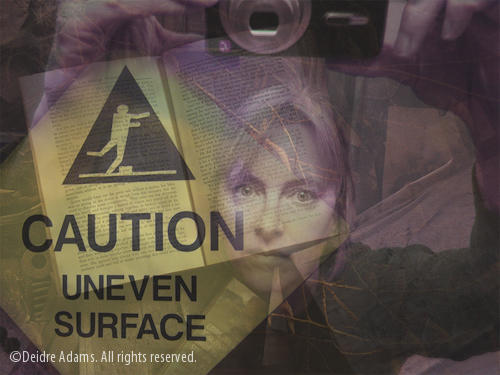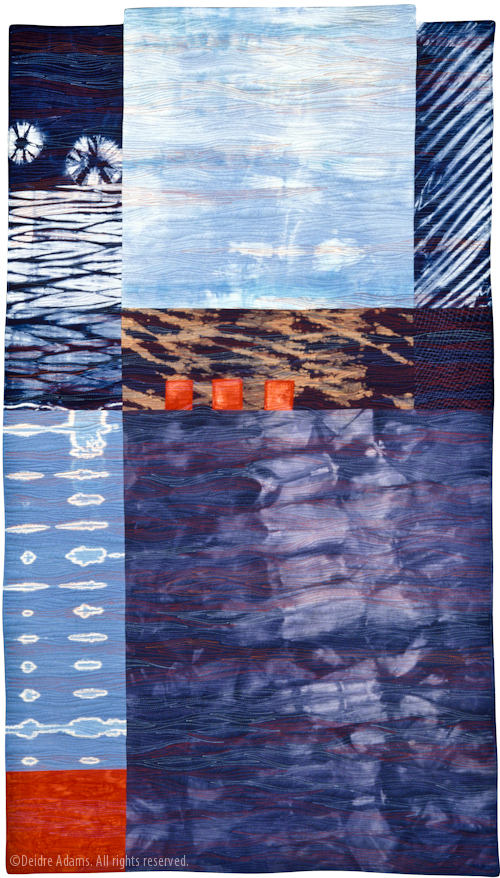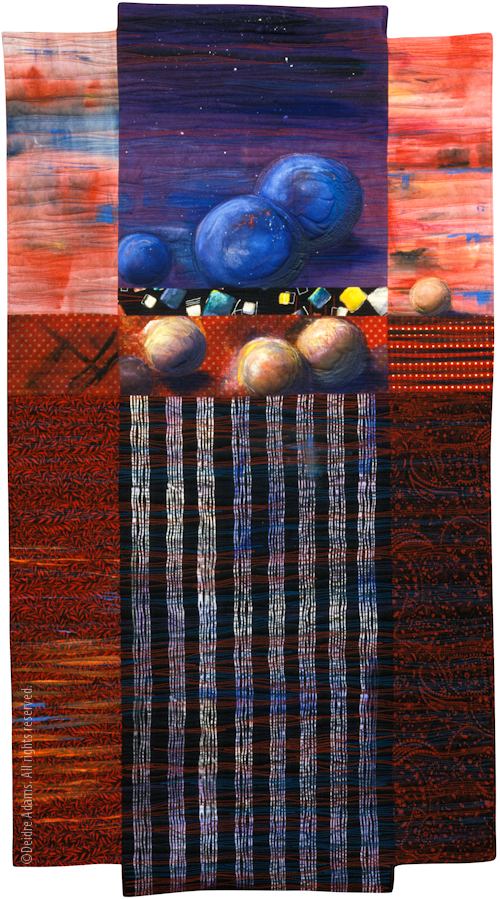
Image from a self-portrait project done in 2003
As part of the curriculum for painting classes at Metro, we are required to do several writing assignments. One of them is to do a written response to a particular book. I had already read the first book on the reading list, so I went to number 2, which was Art & Fear: Observations on the Perils (and Rewards) of Artmaking by David Bayles & Ted Orland. I know, seriously — can you believe I had never read it? Anyway, when I posted on Facebook that I was reading it, a couple of people expressed interest in reading the paper, so I’m posting it here. Yes, it’s probably way too long for a blog post, but here it is anyway.
Response paper – Art & Fear, Part I
As I read this book, I found myself over and over again nodding my head in agreement. Yes, I do that…yes, that too. I make work that doesn’t feel like my own. I leave things unfinished; I repeat myself. I have things in my mind that seem more real than the finished work. Hey wait a minute! Are these guys living inside my head?
Art & Fear is a fast and enjoyable read. It’s full of things that most artists have probably already encountered in one way or another, but it’s reassuring to have them so eloquently articulated and to know that these are common feelings for others. Just the fact that this book exists gives hope to the idea that these misgivings can be overcome once they are properly understood.
The second chapter starts with a sobering fact: There are many in the world who began to make art but most of them quit at some point for whatever reason. The reason might be fear of failure or a feeling of having reached one’s destination. For students, one reason for quitting is graduation from school. (For my own circumstances, I hope I’ll be insulated against this possibility because I started making art long before I decided to go to school for it.)
The authors suggest making friends with others who make art and sharing work in progress as a way to guard against quitting. I’m fortunate in this regard, because I belong to a couple of very supportive groups of textile artists. I’ve also started getting into blogging and social media like Facebook, which have both opened up additional avenues of feedback, encouragement, and support.
Still, the doubts persist. Is my work any good? Do I really have anything to say? Even if I do, does anyone care? Is my work my own, is it authentic? I was reassured by the assertion that “Uncertainty is the essential, inevitable and all-pervasive companion to your desire to make art. And tolerance for uncertainty is the prerequisite to succeeding” (21). Well, I have plenty of uncertainty, so theoretically I should do just fine!
Chapter 3 of the book, “Fears About Yourself, has several subsections. The first is “Pretending.” This one really hit home for me. The notion that I know better than anyone else how much of my art is due to accident or owes to things I’ve seen in other peoples’ art is one of my deep, dark guilty secrets. This gives rise to, as the authors say, imagining that “real artists know what they’re doing, and that they — unlike you — are entitled to feel good about themselves and their art” (24). If one pays attention to art-related magazines and electronic media, the continual discussion of what “art” really is goes on over and over again, and the question is never really resolved because everyone has a different idea about it. It’s comforting to know that I’m not the only one who questions whether what I’m doing is really “art.” Most of the time I don’t bother worrying about it, mostly because I get a lot of enjoyment from doing it, but also because I receive enough positive feedback to keep me from feeling it’s a total waste of time.
The next categories are “Talent,” “Perfection,” “Annihilation,” and “Magic.” To me, these all seem related. Worrying about one’s lack of talent, harboring impossible expectations of perfection, fearing dry spells, or wondering why your work doesn’t just magically create itself are obviously self-defeating, but the trick is figuring out how to overcome these traps. Working with textiles has some built-in advantages here, fortunately. When I’m stuck for ideas, I can work on getting materials into the pipeline. I can put small pieces of fabric together, work on stitching larger pieces, or paint on fabrics or quilts. All of these activities are great for keeping work in progress as well as generating ideas for finished pieces. Similar activities, like doodling or sketching, could work for painters, and there’s probably something similar to be found for every medium. It’s a matter of doing anything you can to keep the creative mind engaged.
Chapter IV, “Fears About Others,” provides some great insights. The expectations put on us by the outside world are numerous and contradictory: We must make art that’s original, yet familiar. We must produce work that’s challenging, yet understandable within the context of what’s gone before. In an academic environment, these expectations carry the added burden of trying to win the acceptance of one’s professors and classmates. In my own experience, this can be a two-edged sword: sometimes the feedback is helpful, but at other times it just works to force me to subvert my own vision.
Seeking approval from others seems to be a basic human need, experienced by everyone at some level. Maybe there are some artists who don’t care at all what others think about their work, but I could never honestly say I’m one of them. I’m certainly not putting myself in the same category as a Stravinsky or a Robert Frank, but if I want to do something different from what’s gone before, I’m often reluctant to show it to others for fear of disapproval or ridicule. These contradictions are something I have to try to ignore or at least work around, lest I become frozen, unable to proceed. I need to keep in mind the authors’ advice: “The only pure communication is between you and your work” (47).
Chapter V is called “Finding Your Work.” It offers interesting observations about the artist’s dual roles as both a maker and a viewer of art. We’ve all been moved or inspired by particular works of art, whether from the standpoint of its impact as a finished piece or because of a specific visual element or technique. In trying to make use of or perhaps pay homage to the feelings these works inspire, we may try to borrow some of the imagery, symbolism, or techniques of another artist. The authors caution against the attempt to “incorporate the power” of a symbol that belongs to another culture, place, or time into one’s own work “under pressure of impending irrelevance” (55). They also similarly caution against using techniques that appear in work we admire, but I disagree with them on that minor point. I believe there’s a lot to be learned by trying different techniques, and we can’t invent a new wheel every time.
We fear running out of ideas, or we may worry that where we’ve been going was down the wrong path. When regarding a finished work, we may wish that we had done certain things differently. But it’s important to keep in mind that an honest evaluation of finished work, even the disappointing aspects, provides a learning experience for all the work to come after it. My favorite quote in the book helps me to understand that even the mediocre or just plain bad work does hold some kernels of knowledge for the future: “The undeniable fact is that your art is not some residue left after you subtract all the things you haven’t done — it is the full payoff for all the things you have done” (56).
The message this book offers is that despite all of our fears and misgivings, the important thing is just to keep doing the work. Not only does the work itself offer valuable understanding and insight for future endeavors, but the practice of doing the work helps us to develop habits and rituals that will keep us working and going forward. We develop a certain vocabulary of marks, colors, and working methods that are used in a subconscious way, “engaging unarticulated beliefs and assumptions about what artmaking is” (59). After some unspecified length of time spent in our practice, we begin to choose certain materials, adjust our environment, and proceed to work in a particular way without even thinking about it. These things give the artist the confidence to keep going, even when fear and uncertainty intrude. They are “canons,” and they are part of the life of the artist.




